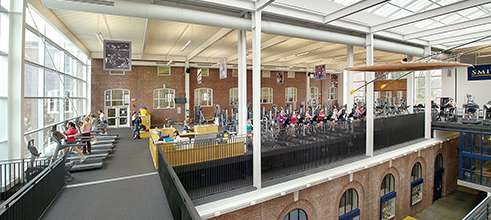Document Type
Article
Publication Date
4-4-2023
Publication Title
Circulation
Abstract
Background: Large-scale human and mechanistic mouse studies indicate a strong relationship between the microbiome-dependent metabolite trimethylamine N-oxide (TMAO) and several cardiometabolic diseases. This study aims to investigate the role of TMAO in the pathogenesis of abdominal aortic aneurysm (AAA) and target its parent microbes as a potential pharmacological intervention. Methods: TMAO and choline metabolites were examined in plasma samples, with associated clinical data, from 2 independent patient cohorts (N=2129 total). Mice were fed a high-choline diet and underwent 2 murine AAA models, angiotensin II infusion in low-density lipoprotein receptor-deficient (Ldlr-/-) mice or topical porcine pancreatic elastase in C57BL/6J mice. Gut microbial production of TMAO was inhibited through broad-spectrum antibiotics, targeted inhibition of the gut microbial choline TMA lyase (CutC/D) with fluoromethylcholine, or the use of mice genetically deficient in flavin monooxygenase 3 (Fmo3-/-). Finally, RNA sequencing of in vitro human vascular smooth muscle cells and in vivo mouse aortas was used to investigate how TMAO affects AAA. Results: Elevated TMAO was associated with increased AAA incidence and growth in both patient cohorts studied. Dietary choline supplementation augmented plasma TMAO and aortic diameter in both mouse models of AAA, which was suppressed with poorly absorbed oral broad-spectrum antibiotics. Treatment with fluoromethylcholine ablated TMAO production, attenuated choline-augmented aneurysm initiation, and halted progression of an established aneurysm model. In addition, Fmo3-/-mice had reduced plasma TMAO and aortic diameters and were protected from AAA rupture compared with wild-type mice. RNA sequencing and functional analyses revealed choline supplementation in mice or TMAO treatment of human vascular smooth muscle cells-augmented gene pathways associated with the endoplasmic reticulum stress response, specifically the endoplasmic reticulum stress kinase PERK. Conclusions: These results define a role for gut microbiota-generated TMAO in AAA formation through upregulation of endoplasmic reticulum stress-related pathways in the aortic wall. In addition, inhibition of microbiome-derived TMAO may serve as a novel therapeutic approach for AAA treatment where none currently exist.
Keywords
aortic aneurysm, abdominal, endoplasmic reticulum stress, gastrointestinal microbiome, PERK kinase, trimethylamine
Volume
147
Issue
14
First Page
1079
Last Page
1096
DOI
10.1161/CIRCULATIONAHA.122.060573
ISSN
00097322
Version
Version of Record
Recommended Citation
Benson, Tyler W.; Conrad, Kelsey A.; Li, Xinmin S.; Wang, Zeneng; Helsley, Robert N.; Schugar, Rebecca C.; Coughlin, Taylor M.; Wadding-Lee, Caris; Fleifil, Salma; Russell, Hannah M.; Stone, Timothy; Brooks, Michael; Buffa, Jennifer A.; Mani, Kevin; Björck, Martin; Wanhainen, Anders; Sangwan, Naseer; Biddinger, Sudha; Bhandari, Rohan; Ademoya, Akiirayi; Pascual, Crystal; Tang, W. H.Wilson; Tranter, Michael; Cameron, Scott J.; Brown, J. Mark; Hazen, Stanley L.; and Owens, A. Phillip, "Gut Microbiota-Derived Trimethylamine N-Oxide Contributes to Abdominal Aortic Aneurysm Through Inflammatory and Apoptotic Mechanisms" (2023). Exercise and Sport Studies: Faculty Publications, Smith College, Northampton, MA.
https://scholarworks.smith.edu/ess_facpubs/47


